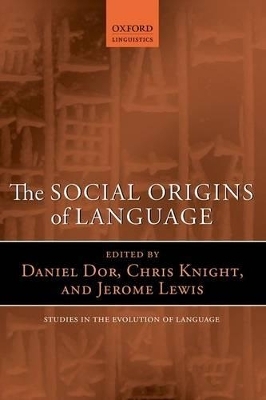
The Social Origins of Language
Oxford University Press (Verlag)
978-0-19-966533-4 (ISBN)
This book offers an exciting new perspective on the origins of language. Language is conceptualized as a collective invention, on the model of writing or the wheel, and the book places social and cultural dynamics at the centre of its evolution: language emerged and further developed in human communities already suffused with meaning and communication, mimesis, ritual, song and dance, alloparenting, new divisions of labour and revolutionary changes in social relations. The book thus challenges assumptions about the causal relations between genes, capacities, social communication and innovation: the biological capacities are taken to evolve incrementally on the basis of cognitive plasticity, in a process that recruits previous adaptations and fine-tunes them to serve novel communicative ends. Topics include the ability brought about by language to tell lies, that must have confronted our ancestors with new problems of public trust; the dynamics of social-cognitive co-evolution; the role of gesture and mimesis in linguistic communication; studies of how monkeys and apes express their feelings or thoughts; play, laughter, dance, song, ritual and other social displays among extant hunter-gatherers; the social nature of language acquisition and innovation; normativity and the emergence of linguistic norms; the interaction of language and emotions; and novel perspectives on the time-frame for language evolution. The contributors are leading international scholars from linguistics, anthropology, palaeontology, primatology, psychology, evolutionary biology, artificial intelligence, archaeology, and cognitive science.
Daniel Dor has a PhD in Linguistics from Stanford University, and is Senior Lecturer in Communication at Tel Aviv University. His main interest lies in the development of a theory of language as a communication technology. Together with Eva Jablonka, he has written extensively on the evolution of language. In a different (but related) domain, Dor has published books and articles on the role of the media, and its language, in the construction of political hegemony. His Intifada Hits the Headlines was chosen as book of the year 2004 in communication by Choice Magazine. Chris Knight was for many years Professor of Anthropology at the University of East London, although he is now retired. Best known for his 1991 book, Blood Relations: Menstruation and the Origins of Culture, he co-founded the Evolution of Language (EVOLANG) series of international conferences and has published widely on the evolutionary emergence of language and symbolic culture. Jerome Lewis lectures in Social Anthropology at University College London and co-directs the Hunter-Gatherer Resilience Project, the Extreme Citizen Science Research Group and UCL's Environment Institute. His research focuses on Pygmy hunter-gatherers and former hunter-gatherers in Central Africa. Current research focuses on communication and cultural transmission in egalitarian hunter-gatherer societies.
PART 1 THEORETICAL FOUNDATIONS; PART 2 LANGUAGE AS A COLLECTIVE OBJECT; PART 3 APES AND PEOPLE, PAST AND PRESENT; PART 4 THE SOCIAL ORIGINS OF LANGUAGE; PART 5 THE JOURNEY THEREAFTER
| Erscheint lt. Verlag | 10.7.2014 |
|---|---|
| Reihe/Serie | Oxford Studies in the Evolution of Language ; 19 |
| Verlagsort | Oxford |
| Sprache | englisch |
| Maße | 167 x 234 mm |
| Gewicht | 686 g |
| Themenwelt | Geisteswissenschaften ► Sprach- / Literaturwissenschaft ► Sprachwissenschaft |
| Naturwissenschaften ► Biologie ► Evolution | |
| Naturwissenschaften ► Biologie ► Zoologie | |
| Sozialwissenschaften ► Ethnologie | |
| Sozialwissenschaften ► Soziologie | |
| ISBN-10 | 0-19-966533-8 / 0199665338 |
| ISBN-13 | 978-0-19-966533-4 / 9780199665334 |
| Zustand | Neuware |
| Haben Sie eine Frage zum Produkt? |
aus dem Bereich


